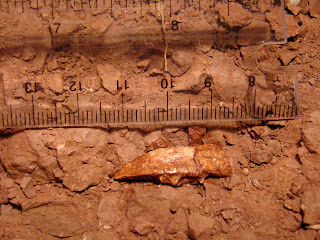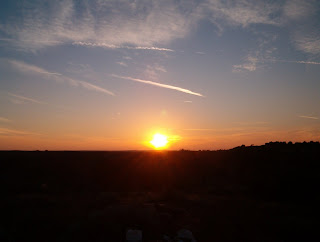Or rather, out. And in to the world for the first time in 250 million years.
As we've previously shared, one of the plaster jackets holding fossils excavated from the Museum's site in Seymour is currently being housed at The Woodlands Xploration Station, an educational satellite of HMNS.
Dr. Bakker, David, Chris and Heather, a new volunteer at the Xploration Station, have all been working to excavate inside the jacket and figure out just what they brought back.

New Xploration Station Volunteer Heather Conklin works on excavating one of the plaster jackets brought back from Seymour. For the Conklins, science is a family affair.
Due to the jacketing process, they're actually digging from the bottom back up to the original surface of hte layer. The bones that they found closer to the surface in Seymour are actually at the bottom of this jacket. So no one knew if the dirt underneath (what they are digging now) would have a bunch of bones, or...nothing at all.
Just because they're not in the field doesn't mean they're any less
meticulous about how and where each bone is discovered. According to Chris:
"We’ve slowly been removing matrix (dirt) exposing the bones and mapping their position; this includes taking pictures, and mapping them by finding compass direction and dip angle. Then we remove and package them for protection. A lot of the bones have been badly chewed and worn, suggesting that the level we are working on could possibly hold the remains of a Permian dinner. Two teeth have been found at this level, which supports that theory. After all the bones of the top level of the jacket were removed, there has been a lull in bone discovery in the next 10 to 20 millimeters. We have yet to reach a secondary bone level."
 This claw may be from a Dimetrodon.
This claw may be from a Dimetrodon.

This Dimetrodon neural spine has been covered with a coat of vinac to protect it.

A small, unidentified vertebra.

This tiny, serrated tooth might be from a Dimetrodon.
They've also made some cool discoveries by going through what they bagged from the surface and excavations.
For example, someone might have a hunch a piece of rock is really something more - but you can't really figure it out in the field. So, they stick it in a bag, protect it with some foil if necessary, mark the bag with the name of the locality and move on. Also, when you're excavating a layer, you sometimes have to remove fossils in order to keep digging.
Now that the team has had some time to get all those pieces back out and look through them again, they've made a cool discovery.

The picture above shows two pieces of an
Eryops bone. The larger half, in the foreground, was picked up in Seymour and then prepped out in Houston by David (a process by which he removed all the caliche and other material covering the fossil). He was showing it to Dr. Bakker, who happened to be looking through a bag of bone pieces from the same locality. While sorting through the bag, they found what looks to be the other half! (Shown in the background of the photo).
They left the other half un-prepped to illustrate the difference between fossils as they are found (the background) and as they look once prepared for display (foreground). You can see the difference in the level of detail that is evident in the prepped half.
 The root of a Dimetrodon fang, as seen from the top.
The root of a Dimetrodon fang, as seen from the top.
 The entire Dimetrodon fang that was found.
The entire Dimetrodon fang that was found.
***If you're new to the blog, be sure to check out all the links at right. You can follow daily reports from the last dig, in early November, and learn all about the various species the team is finding fossils of. Lots of Dr. Bakker's illustrations and photos are posted, as well.

 This Dimetrodon toe bone was discovered in the plaster jacket the team brought back from the site. The jacket is being excavated at The Woodlands Xploration Station.
This Dimetrodon toe bone was discovered in the plaster jacket the team brought back from the site. The jacket is being excavated at The Woodlands Xploration Station.  Another image of the Dimetrodon toe bone, which gives it's specific size. From this, you can imagine how large the entire foot would be, as well as the full animal.
Another image of the Dimetrodon toe bone, which gives it's specific size. From this, you can imagine how large the entire foot would be, as well as the full animal. 

























+of+olmpPFE+175.JPG)



























